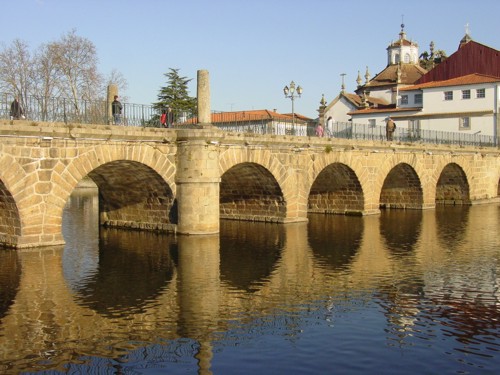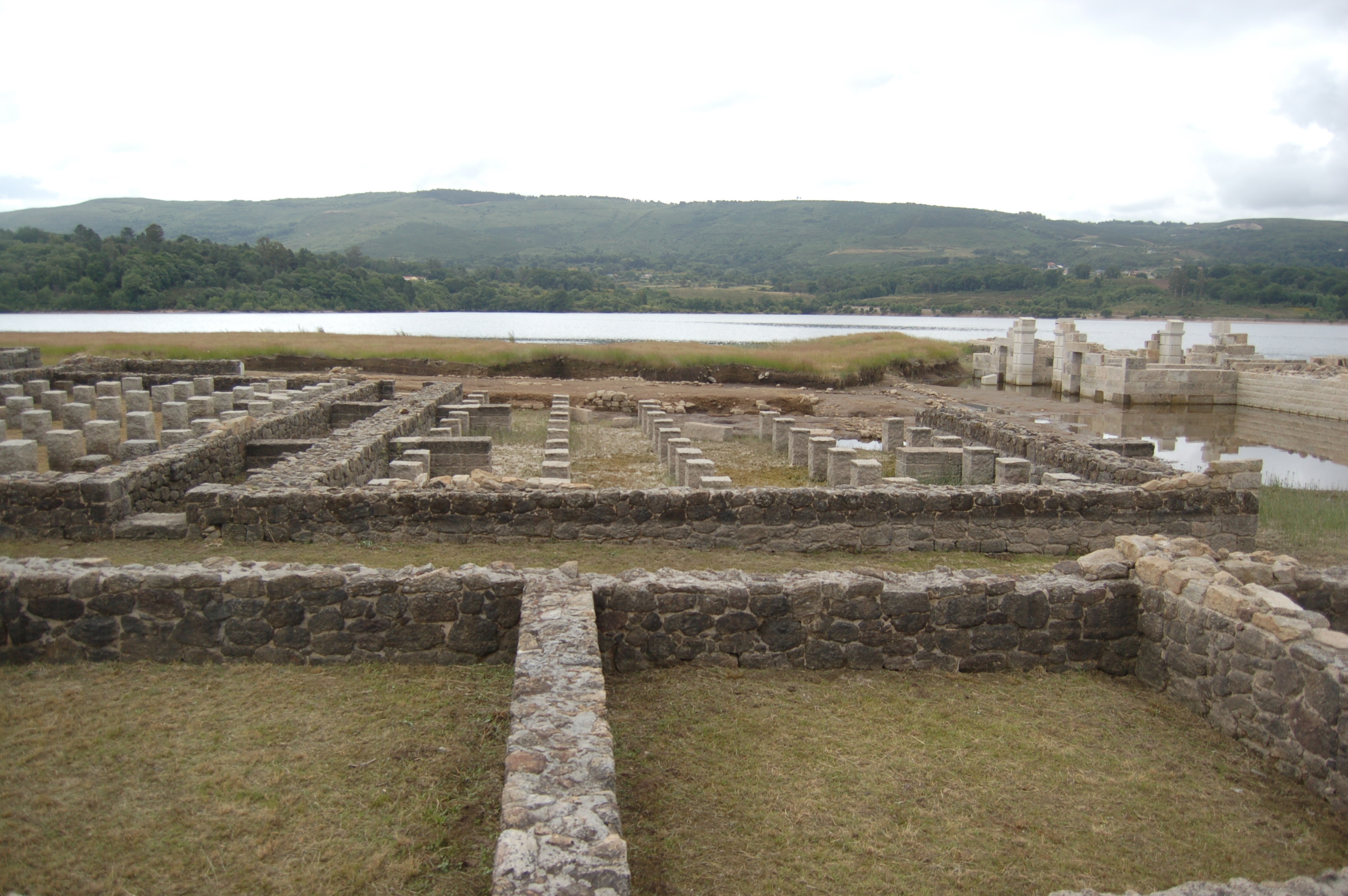|
Coelerni
The Coelerni were an ancient Celtic tribe of Gallaecia in Hispania (the Iberian Peninsula), part of Calaician or Gallaeci people, living in what was to become the Roman Province of Hispania Tarraconensis, in what is now the southern part of the province of Ourense (in Galicia). Some sources, like Alarcão, also state that the Coelerni lived in the north of modern Portugal, in the province of Trás-os-Montes, in the mountains between the rivers Tua and Sabor - this seems to be incorrect and predates the finding of the Tessera Hospitalis of Castromao. However there was a lusitanian people of the Colarni (inscription of Alcantara) living near the Douro river in Lamego, that could have some link with the galician Coelerni. Classical Sources The Coelerni are known from few literary sources, such as Pliny and Ptolemy, and because they appear as one of the ten civitates of the convent Bracarensis that are cited in the Inscription of the Peoples of Chaves (the Roman Aquae Flaviae), a ... [...More Info...] [...Related Items...] OR: [Wikipedia] [Google] [Baidu] |
Callaici
The Gallaeci (also Callaeci or Callaici; grc, Καλλαϊκοί) were a Celtic tribal complex who inhabited Gallaecia, the north-western corner of Iberia, a region roughly corresponding to what is now the Norte Region in northern Portugal, and the Spanish regions of Galicia, western Asturias and western León before and during the Roman period. They spoke a Q-Celtic language related to Northeastern Hispano-Celtic, called Gallaecian or Northwestern Hispano-Celtic. The region was annexed by the Romans in the time of Caesar Augustus during the Cantabrian Wars, a war which initiated the assimilation of the Gallaeci into Latin culture. The endonym of modern-day Galicians, ''galegos'', derives directly from the name of this people. History The fact that the Gallaeci did not adopt writing until contact with the Romans constrains the study of their earlier history. However, early allusions to this people are present in ancient Greek and Latin authors prior to the conquest, wh ... [...More Info...] [...Related Items...] OR: [Wikipedia] [Google] [Baidu] |
Roman Bridge In Chaves
Trajan's Bridge ( pt, Ponte de Trajano) is a Roman bridge in the civil parish of Santa Maria Maior, in the municipality of Chaves in the Portuguese northern subregion of Terras de Trás-os-Montes. History The bridge was constructed at the end of the 1st century or beginning of the 2nd century, by engineers under the emperor Trajan. A commemorative column was erected in 104, referring to the bridge's construction by Flavian locals, at their cost. the column, now known as the ''Padrão dos Povos'' (''People's Standard'') was erected and dedicated by 10 ''civitas'' towards the Roman emperors Vespasian, Titus, the emperor's Legatus Augusti and the procurator of the 7th Legion ''Gemina Felix''. The bridge was first depicted in the book of Duarte d'Armas in the 16th century, as seen from the eastern bank, showing 14 arches, interlinked by ''talhamares'' with guards, and on the northern bank some watermills. On 7 December 1514, the first foral (''charter'') was issued by King D. ... [...More Info...] [...Related Items...] OR: [Wikipedia] [Google] [Baidu] |
Aquae Flaviae
Aquae Flaviae (or ''Aquæ Flaviæ'') is the ancient Roman city and former bishopric (now a Latin Catholic titular see) of Chaves, a municipality in the Portuguese district of Vila Real. History The northwest peninsular region is an area of hot springs and Roman settlements linked to the exploitation of valuable natural resources.Diana Fonseca Sorribas (2012), p.519 Aquae Flaviae was the principal '' municipium civitas'' in the northwest (from epigraphic findings) implanted in the Trás-os-Montes, on a small hill on the banks of the River Tâmega, in the Roman province of Gallaecia. This was a fertile area, where hot springs abound, in addition to a mining region from which gold is extracted. It is also located in a strategic place between the Roman cities of Bracara and Asturica, as well as the mining districts of Três Minas and Jales, located southwest of the ''civitates''. Little is known of the urban fabric although there are some important points: an aqueduct supplied ... [...More Info...] [...Related Items...] OR: [Wikipedia] [Google] [Baidu] |
Chaves (Portugal)
Chaves () is a city and a municipality in the north of Portugal. It is 10 km south of the Spanish border and 22 km south of Verín (Spain). The population in 2011 was 41,243, in an area of 591.23 km2. The municipality is the second most populous of the district of Vila Real (the district capital, Vila Real, is 60 km south on the A24 motorway). With origins in the Roman civitas Aquæ Flaviæ, Chaves has developed into a regional center. The urban area has 17,535 residents (2001). History Artefacts discovered in the region of Chaves identify the earliest settlement of humans dating back to the Paleolithic. Remnants discovered in Mairos, Pastoria and São Lourenço, those associated with transient proto-historic settlements and castros, show a human presence in the Alto Tâmega dating to the Chalcolithic. The region has seen persistent human settlement since Roman legions conquered and occupied the fertile valley of the Tâmega River, constructing a na ... [...More Info...] [...Related Items...] OR: [Wikipedia] [Google] [Baidu] |
Tamagani
The Tamagani were an ancient Celtic tribe of Gallaecia, living in the north of modern Portugal, in the province of Trás-os-Montes, in the area of Chaves, near the river Tâmega. See also *Pre-Roman peoples of the Iberian Peninsula This is a list of the pre- Roman people of the Iberian Peninsula (the Roman Hispania, i. e., modern Portugal, Spain and Andorra). Some closely fit the concept of a people, ethnic group or tribe. Others are confederations or even unions of t ... External linksDetailed map of the Pre-Roman Peoples of Iberia (around 200 BC) Tribes of Gallaecia Ancient peoples of Portugal {{Portugal-hist-stub ... [...More Info...] [...Related Items...] OR: [Wikipedia] [Google] [Baidu] |
Quaquerni
The Quaquerni or Querquerni were an ancient tribe of Gallaecia, living in the ''Baixa Limia'' region of southern Galicia, where the Roman fort of ''Aquis Querquennis'' has been found. Ethnonym Historical sources The Quaquerni are also known by the name ''Quarquerni'', ''Querquernoi'', or ''Quacernoi''. Their ethnomyn is registered as (Kouakernoí), by Greek geographer Ptolemy in his ''Geographies''. Scholars see a possible connection with Venetic ''Quarqueni'', as registered by Pliny and located somewhere in historical Istria.Moralejo, Juan J. "Labiovelares en material galaico y lusitano". In: ''Callaica Nomina: Estudios de Onomástica Gallega''. Biblioteca Filolóxica Galega. Fundación Pedro Barrié de la Maza, D.L. 2007. pp. 231. Etymology The name ''Querquerni'' is probably related to Latin ''quercus'' ("oak"), which stems from Proto-Indo-European root *''pérkʷus'', meaning "oak". It is probably a Q-Celtic formation meaning "the Oak People / Warriors",, s.v. ''Quarquerni' ... [...More Info...] [...Related Items...] OR: [Wikipedia] [Google] [Baidu] |
Limici
The Limici were an ancient Celtic tribe of Gallaecia, living in the swamps of the river Lima, in the border region between Minho (Portugal) and Galicia (Spain). See also *Pre-Roman peoples of the Iberian Peninsula This is a list of the pre- Roman people of the Iberian Peninsula (the Roman Hispania, i. e., modern Portugal, Spain and Andorra). Some closely fit the concept of a people, ethnic group or tribe. Others are confederations or even unions of t ... External linksDetailed map of the Pre-Roman Peoples of Iberia (around 200 BC) Tribes of Gallaecia Ancient peoples of Portugal {{Portugal-hist-stub ... [...More Info...] [...Related Items...] OR: [Wikipedia] [Google] [Baidu] |
Interamici
The Interamici or Interamnici were a pre-Roman people or tribe, one of the Gallaeci tribes, living between some areas of modern southern Galicia (Spain) (in part of southern Ourense Province), and some areas of northern Trás-os-Montes, modern northeast Portugal. Their name means "Between Waters" (Between Rivers) because they lived between the southern banks of the '' Minius'' ( Minho) and Sil rivers and the northern headwaters of the '' Laethes'' or '' Limia'' (Lima) and '' Tamica'' ( Tâmega) rivers. See also *Pre-Roman peoples of the Iberian Peninsula This is a list of the pre- Roman people of the Iberian Peninsula (the Roman Hispania, i. e., modern Portugal, Spain and Andorra). Some closely fit the concept of a people, ethnic group or tribe. Others are confederations or even unions of t ... References External linksDetailed map of the Pre-Roman Peoples of Iberia (around 200 BC) Ancient peoples of Portugal {{Portugal-hist-stub ... [...More Info...] [...Related Items...] OR: [Wikipedia] [Google] [Baidu] |
Equaesi
The Equaesi were an ancient Celtic tribe of Gallaecia, who lived in the north of modern Portugal, between the provinces of Minho and Trás-os-Montes, near the border of modern Galicia (Spain). See also *Pre-Roman peoples of the Iberian Peninsula This is a list of the pre- Roman people of the Iberian Peninsula (the Roman Hispania, i. e., modern Portugal, Spain and Andorra). Some closely fit the concept of a people, ethnic group or tribe. Others are confederations or even unions of t ... External linksDetailed map of the Pre-Roman Peoples of Iberia (around 200 BC) Tribes of Gallaecia Galician Celtic tribes Ancient peoples of Portugal {{europe-ethno-group-stub ... [...More Info...] [...Related Items...] OR: [Wikipedia] [Google] [Baidu] |
Roman Legion
The Roman legion ( la, legiō, ) was the largest military unit of the Roman army, composed of 5,200 infantry and 300 equites (cavalry) in the period of the Roman Republic (509 BC–27 BC) and of 5,600 infantry and 200 auxilia in the period of the Roman Empire (27 BC – AD 476). Size The size of a typical legion varied throughout the history of ancient Rome, with complements ranging from 4,200 legionaries and 300 equites (drawn from the wealthier classes – in early Rome all troops provided their own equipment) in the Republican period of Rome (the infantry were split into 10 Cohort (military unit), cohorts each of four Maniple (military unit), maniples of 120 legionaries), to 4,800 legionaries (in 10 cohorts of 6 centuries of 80 legionaries) during Caesar's age, to 5,280 men plus 120 auxiliaries in the Imperial period (split into 10 cohorts, nine of 480 men each, with the first cohort being double-strength at 960 men). It should be noted the above numbers are typical fi ... [...More Info...] [...Related Items...] OR: [Wikipedia] [Google] [Baidu] |
Legionary
The Roman legionary (in Latin ''legionarius'', plural ''legionarii'') was a professional heavy infantryman of the Roman army after the Marian reforms. These soldiers would conquer and defend the territories of ancient Rome during the late Republic and Principate eras, alongside auxiliary and cavalry detachments. At its height, Roman legionaries were viewed as the foremost fighting force in the Roman world, with commentators such as Vegetius praising their fighting effectiveness centuries after the classical Roman legionary disappeared. Roman legionaries were recruited from Roman citizens under age 45. They were first predominantly made up of recruits from Roman Italy, but more were recruited from the provinces as time went on. As legionaries moved into newly conquered provinces, they helped Romanize the native population and helped integrate the disparate regions of the Roman Empire into one polity. They enlisted in a legion for 25 years of service, a change from the early pra ... [...More Info...] [...Related Items...] OR: [Wikipedia] [Google] [Baidu] |





.jpg)
